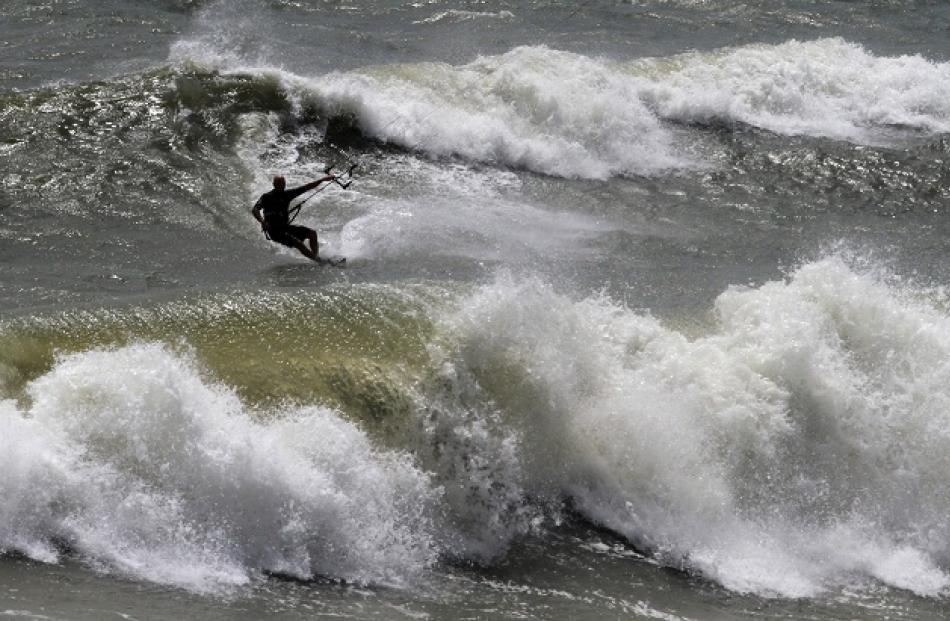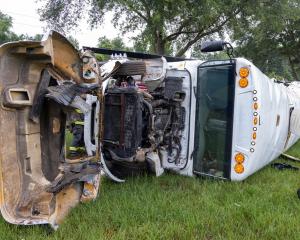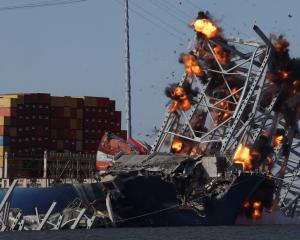The northeast US seaboard, including the capital, Washington, and financial centre New York, is rushing to prepare for a possible mauling from powerful Hurricane Irene this weekend.
From the Carolinas to Cape Cod, more than 50 million people were potentially in Irene's path. States, cities, ports, industries, oil refineries and nuclear plants scrambled to activate emergency plans, while residents stocked up on food and water and worked to secure homes, vehicles and boats.
The US Navy sent the ships of its Second Fleet out of port at Hampton Roads, Virginia, to ride out the expected powerful storm at sea.
Irene, a major Category 3 hurricane, battered the low-lying Bahamas southeast of Florida on Thursday and was expected to sweep northward to hit the North Carolina coast on Saturday, before raking the remaining Atlantic seaboard.
"All the major metropolitan areas along the Northeast are going to be impacted," National Hurricane Centre Director Bill Read told Reuters Insider. "Being a large hurricane, tropical storm-force winds will extend far inland."
President Barack Obama declared a state of emergency in North Carolina, authorizing federal aid to support the state's storm response.
After hitting North Carolina, Irene was expected to weaken to a still-dangerous Category 2 storm on the five-step Saffir-Simpson intensity scale, still strong enough to slam dozens of Atlantic beach communities in Delaware, Maryland and Virginia this weekend before heading to New York on Monday. A Category 2 storm carries winds of 154-177kmh.
Read said Irene could mimic the path of Hurricane Gloria in 1985, a Category 3 storm that hit North Carolina's Outer Banks and then slammed into New York's Long Island and curved through New England, causing $900 million of damage.
US Federal Emergency Management Agency Administrator Craig Fugate briefed Obama and other top officials on the threat from Irene, which included tropical-storm-force winds or worse in Washington.
Irene forced the cancellation of Sunday's dedication ceremony for the new memorial honouring civil rights leader Martin Luther King Jr. on the National Mall in Washington. Tens of thousands of people, including Obama, had had been expected to attend.
Coastal evacuations were under way in North Carolina and were ordered for beach resorts in Virginia, Delaware and Maryland. Virginia Governor Bob McDonnell urged residents to seek shelter by Friday night, before the winds kick up.
"Saturday is going to be a horrendous day for travel. There will be roads and bridges closed," he said.
Hurricane watches and warnings were in effect along the Atlantic coast from North Carolina to New Jersey. The governors of North Carolina, Virginia, Maryland, Delaware, New Jersey, New York and Connecticut declared emergencies for Irene.
"From a flooding perspective, this could be a hundred-year event," New Jersey Governor Chris Christie said.
Irene will be the first hurricane to hit the US mainland since Ike pounded Texas in 2008.
Earlier today Irene had sustained winds of 185kmh and its centre was about 930kmh south-southwest of Cape Hatteras, North Carolina.
New York Mayor Michael Bloomberg said the United States' most populous city was bracing to experience at least tropical storm conditions and flooding starting on Sunday. Irene could hit Long Island, which extends due east from the city, as a Category 2 hurricane.
The city was positioning rescue boats and helicopters and working to minimize street flooding. Hospitals and nursing homes in low-lying areas were ordered to evacuate unless they obtained permission to stay open.
"The city has already seen the power of Mother Nature once this week, and Mother Nature may not be done with us yet," Bloomberg said, referring to Tuesday's earthquake that shook the East Coast, frightening millions but causing no deaths.
He urged residents of vulnerable areas to move to safety on Friday because the New York City mass transit system, the nation's biggest with 8 million passengers a day, may have to be shut on Saturday if flooding or high winds endanger its buses, subways and commuter trains. Many New Yorkers do not have cars, so mass transit could be vital in evacuations.
Forecasters warned that even if the center of Irene stays offshore as it tracks up the Mid-Atlantic coast, its wide bands could lash cities like Washington, Baltimore, Philadelphia and New York with winds and flooding rain, and knock out power.
Oil terminals, refineries and nuclear plants from the Bahamas to Rhode Island were preparing.
Forecasters went out of their way to emphasize the risks for the densely populated US northeast, which has not had a direct hit from a hurricane in decades.
"Irene is capable of inundating portions of the coast under 3-4.5m of water, to the highest storm surge depths ever recorded," hurricane expert Jeff Masters of private forecaster Weather Underground wrote in his blog.
Flooding from Irene killed at least one person in Puerto Rico and two in the Dominican Republic. The storm knocked out power in the Bahamian capital Nassau on Thursday and blocked roadways with fallen trees.
The Bahamas National Emergency Management Agency said there were reports that 90 percent of the homes and structures were destroyed in some settlements in the southeast Acklins and Crooked Islands.
The storm missed Florida but whipped up massive swells along its coast. Eight people were injured in the southeast city of Boynton Beach on Thursday when they went out on a jetty to gawk at the sea and were knocked down by a giant wave.













